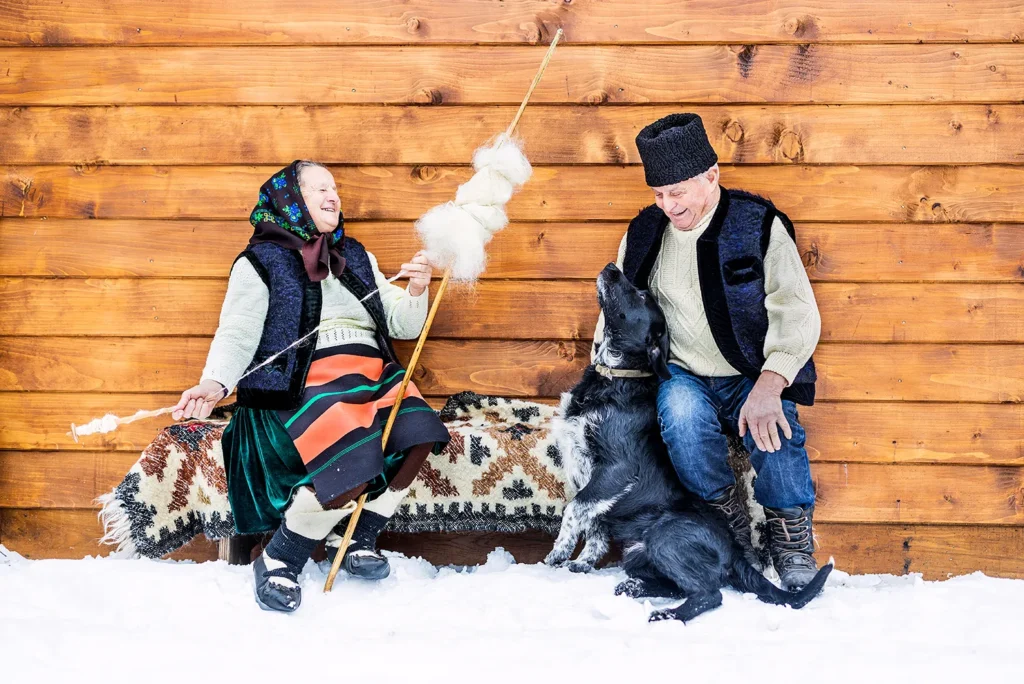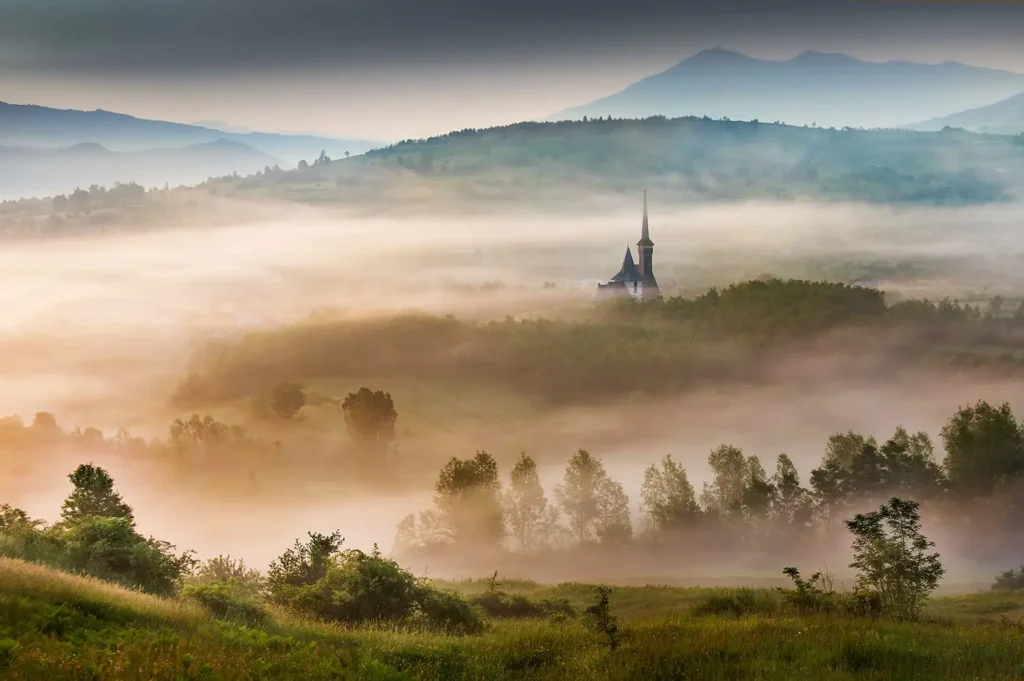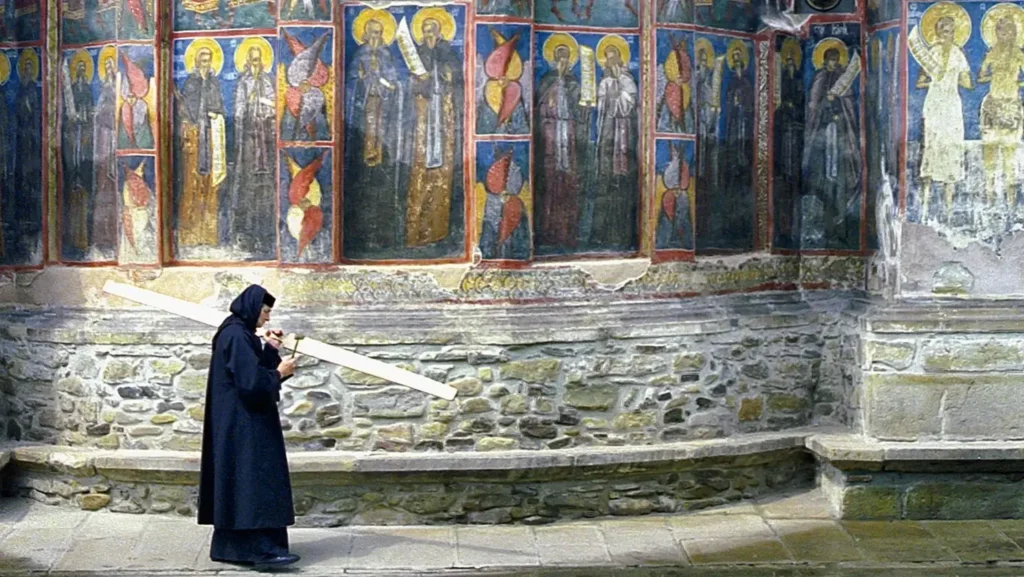Chapters
When you visit Romania, you quickly realise that “tradition” here isn’t something tucked away in a museum. It’s in kitchens, courtyards, churches, and at family tables. Babies are still blessed in ways that echo fairy tales, weddings spill into the street with music and playful rituals, and villagers light bonfires on cold nights to mark the change of seasons.
For many travelers, these Romanian traditions feel a little unexpected — and that’s exactly what makes them special. They’re not performances for tourists but genuine habits handed down from grandparents to grandchildren. Even if the original religious or magical reasons have faded, people keep doing them because they feel right: they bring families together, they honor life’s milestones, they connect past and present.
Seeing these customs up close is like being let in on a secret: you understand a country not just by its landmarks but by how its people celebrate, mourn, welcome and protect one another. That’s what Romanian traditions offer — a living, everyday culture that’s as surprising as it is warm.
Birth & Childhood Traditions
Romanian traditions don’t wait until adulthood to show up. They start as soon as a baby arrives, weaving blessings, playful rituals and a bit of old magic into the child’s first months of life.
The Fairy Godmothers (Ursitoarele)
At many christening parties (cumătrie) you’ll still see three ursitoare — women dressed like fate fairies from an old story. They come to the party, sing or chant blessings and symbolically “weave” the baby’s destiny. It’s a tradition that feels like stepping into the Sleeping Beauty fairytale and shows how seriously families take the idea of protecting a newborn’s future – through magic.
 Photo source: zanebune.ro
Photo source: zanebune.ro
The Taking Out of the Myrrh (Scoaterea din Mir or Băița de a doua zi)
The morning after the baptism, the godparents prepare a special bath for the baby. Into the water they add basil, flowers, coins, honey and even milk, each ingredient carrying a meaning: purity, health, sweetness, prosperity. The baby is then bathed there. Neighbors and relatives gather to watch and wish the baby well. It feels like a small folk ceremony happening right in someone’s home.
The First Birthday Ritual (Tăierea Moțului & Alesul de pe Tavă)
When the child turns one, the godparents cut a small lock of hair, tie it with a ribbon and stick it to a silver coin using candle wax. This becomes a blessing that parents keep forever. Then they place a tray with objects — a pen, a mirror, jewelry, stethoscope, a musical instrument, money, keys, kitchen tool, icon — in front of the child. The item the baby picks is said to hint at their future. It’s playful fortune-telling, but families still take it to heart, smiling as they guess what kind of life the little one will have.
 Photo source: mariuspavel.ro
Photo source: mariuspavel.ro
Wedding Traditions
Among all Romanian traditions, weddings are some of the liveliest and most surprising for visitors. In villages and towns alike, a wedding is not just a single day but a string of customs that bring families, neighbors, and sometimes the whole community together. Many of these rituals blend humor and symbolism, turning the celebration into a living piece of folklore.
The Groom’s Shave (Bărbieritul Mirelui)
On the wedding morning, the groom’s friends gather at his house to “shave” him one last time as a bachelor. They lather his face, sometimes with whipped cream instead of soap, and pretend to shave him with a wooden knife while musicians play. It’s light-hearted and funny, but also a way of showing support before he starts a new life.

Photo source: claudiufotografnunta.ro
Breaking Bread over the Bride (Ruperea Turtei)
Before leaving for the church ceremony, the godmother breaks a beautifully decorated braided bread roll over the bride’s head. She then throws pieces at the guests who are supposed to eat them, believing the crumbs bring fertility, prosperity, and good luck. It really looks like playful chaos, but it’s a heartfelt blessing.

Photo source: style-up.ro
Stealing the Bride (Furatul Miresei)
At the reception, friends “kidnap” the bride and whisk her off to a nearby bar or even the town square. One of the thieves usually returns to the party venue carrying one of the bride’s shoes. The groom has to “ransom” her back — by dancing, singing, or paying a symbolic fee. This tradition injects humor into the party and keeps everyone involved.
The Chicken Dance (Dansul Găinii)
Once a serious fertility ritual, today the “chicken dance” is mostly for laughs. A decorated chicken (real or symbolic) is paraded around or danced with before being served at the feast. The parade is a show by itself: the person carrying the chicken performs the crowing of the hen (strigătura găinii), a specific folk song for this moment. Guests contribute money to the person carrying it, which is then gifted to the couple.

Photo source: medium.com
Funeral and Memorial Traditions
Some of the most striking Romanian traditions appear not at weddings or baptisms, but at the end of life. Funerals here still carry layers of ritual that can surprise outsiders. They’re a mix of Orthodox rites and old folk customs meant to help the soul on its journey and to keep the living connected to their ancestors.
Three-Day Wake (Trei Zile de Priveghi)
In Romania, the deceased used to be kept at home for three days before the funerals. The law from 2016 states that families must use a funeral chapel for the three-days wake now. Family, friends and neighbors come and sit with the body, pray, and share food. Wake is a time for laughter and remembrance – family and friends share stories of the deceased and try to remember the happy moments that they shared. For a foreign visitor used to quick service and burial, it can feel intense — but it’s a way of honoring the person, showing they are not left alone, and giving everyone time to say goodbye.
Covering Mirrors (Acoperirea Oglinzilor)
During the wake, mirrors in the house are covered with cloth. People say it stops the soul from getting trapped or spares the living from bad luck. It’s one of those small, quiet Romanian traditions that reveals how everyday objects can carry symbolic weight.
Hen over the Grave (Găina Peste Groapă)
In some rural areas, a live hen is passed over the grave or released during the funeral. The gesture, which looks strange to outsiders, is a folk offering meant to ease the soul’s passage and “carry away” any remaining sins.
The Romanian Tradition of Burying Unmarried Young People
If an unmarried man or woman dies young, a decorated fir tree is placed at the funeral as a stand-in for the wedding he never had. The fir tree fulfills the role of husband or wife of the deceased in the other world. Usually, young women are also dressed in wedding gown. It’s a poignant custom that acknowledges a life stage left unfulfilled.
Throwing Coins (Aruncatul cu Bani)
As the funeral procession leaves for the church, coins are sometimes scattered on the road or at crossroads. This old practice is said to “pay” the soul’s journey and bring blessings to whoever picks them up.
Memorial Saturdays (Sâmbăta Moșilor)
Every season has its own memorial day but Moșii de iarnă (Saturday before the beginning of the fasting period) and Moșii de vară (Saturday before Pentecost) are the most important. Families go to the cemetery, clean and decorate graves, light candles, and hand out food “for the soul” of the departed. For visitors it feels like a communal picnic of remembrance, showing how deeply Romanians keep ties with their dead.
 Photo source: doxologia.ro
Photo source: doxologia.ro
Romanian Traditions on Patron Saints Nights
One of the most fascinating Romanian traditions for visitors happens not at Easter or Christmas, but at the end of November. Saint Andrew’s Night (Noaptea Sfântului Andrei) is full of customs that mix Orthodox religion with older, pre-Christian beliefs. Saint Andrew is the patron saint of Romania, so his feast day feels like a turning point in the year — much like Halloween and All Saints’ Eve combined.
Basil under the Pillow (Busuioc sub Pernă)
On the eve of Saint Andrew, unmarried girls slip a sprig of basil under their pillow hoping to dream of their future husband. In church tradition, basil is a sacred plant. It is used to sanctify water, which is a main element of religious rituals. This is not the only night when unmarried girls perform this ritual. The nights of Epiphany, Dragobete and Sânziene are also a chance for dreaming about the chosen one. It looks like a sweet superstition, but for Romanians it’s a fun and hopeful ritual that still makes its way into student dorms and city apartments as well as village houses.
Garlic to Ward off Spirits (Usturoi de Sfântul Andrei)
Families rub garlic on windows, doorframes, or even farm animals on Saint Andrew’s Night. It’s meant to protect against strigoi — restless spirits said to roam free at this time of year. Visitors often compare it to “vampire folklore,” but for locals it’s just one of those Romanian traditions you grow up with, half-believed and always done.
 Photo source: monitorulexpres.ro
Photo source: monitorulexpres.ro
Bonfires of St. Dumitru (Focul lui Sâmedru)
A month earlier, on October 25–26, villagers light big bonfires on hillsides for Saint Dumitru. Children jump over the flames for good luck, and embers are sometimes carried home to bless the household. It marks the end of the pastoral year, when shepherds bring their flocks down from the mountains. For a traveler, seeing hills dotted with fires under the autumn sky is unforgettable.
 Photo source: adevarul.ro
Photo source: adevarul.ro
Easter Romanian Traditions
Orthodox Easter is the most important holiday of the year in Romania. Families clean and decorate their homes, bake special breads, and attend midnight services. But what really stands out to visitors are the small gestures at home — the Romanian traditions that turn Easter into a mix of faith, folklore and family playfulness.
Easter Egg Cracking (Ciocnitul Oualor)
On Easter Sunday people greet each other with “Hristos a înviat!” (“Christ has risen!”) while knocking painted eggs together. Whoever’s egg stays uncracked is said to have good luck for the year. It’s joyful, competitive, and symbolic of rebirth.
 Photo source: sstirileprotv.ro
Photo source: sstirileprotv.ro
Washing with Egg and Coin
On the morning of Easter, before going to church, people wash their faces with fresh water from the well, in which they place a red egg, a coin, and a nettle. Everyone in the house washes in turn, each rubbing the red egg over their cheek, saying: may I be healthy and red like the egg; then they take the coin and rub it over their face, saying: may I be proud and clean like silver; they lightly touch themselves with the nettle, saying: may I be rough like the nettle.
 Photo source: muzeuzalau.ro
Photo source: muzeuzalau.ro
Sprinkling Unmarried Girls (Stropitul Fetelor Nemăritate)
In Transylvania and parts of western Romania, boys visit homes on the second day of Easter to sprinkle unmarried girls with perfume or water while reciting short verses. It’s meant to ensure health and beauty, and the girls reward them with painted eggs, cakes, or small gifts. This is one of the Romanian traditions that mixes community, humour, and a hint of old courtship customs.

Photo source: visitmures.com
Christmas Traditions
Christmas in Romania still feels rooted in the village, even in cities. Beyond church services and decorated trees, visitors are struck by how many Romanian traditions come alive during Advent and the 12 days of Christmas.
Pig Slaughter Feast (Tăierea Porcului & Pomana Porcului)
Among the Romanian traditions that surprise visitors most is the pig slaughter on 20 December, Ignat’s Day. In many villages the pig is sacrificed at dawn, before sunrise, to bring luck and prosperity to the household. The first meal with the fresh meat, called pomana porcului, is shared with family and sometimes neighbors as a moment of gratitude. In some regions children are still touched on the forehead with a little pig’s blood for health and good fortune. Afterwards the family works together to prepare sausages, smoked ham and other Christmas delicacies, turning a cold winter morning into a communal ritual of self-reliance and celebration.
 Photo source: stirileprotv.ro
Photo source: stirileprotv.ro
Masked Carolers
Groups of carolers — sometimes dressed as goats, bears, or other fantastical creatures — go from house to house singing and dancing for good luck. Children still learn these songs in school, and even in cities you’ll see carol troupes on Christmas Eve.

Photo source: paginaolteniei.ro
Epiphany Blessing (Boboteaza)
On 6 January priests bless rivers, wells and homes with holy water. In some towns young men dive into icy rivers to retrieve a wooden cross for blessings. Watching it, you feel the mix of Orthodox faith and folk heroism that characterizes many Romanian traditions.

Photo source: eidtiadedimineata.ro
Everyday Beliefs & Welcoming Customs
Not all Romanian traditions are tied to holidays or big life events. Some of the most charming — and surprising — are the small gestures people still make in daily life. They’re quiet reminders that folklore and hospitality are alive, not just remembered.
Spitting to Ward off the Evil Eye (Scuipatul de Deochi)
When someone compliments a baby or a new house, many Romanians still pretend to spit three times (“ptu, ptu, ptu”) to keep envy and bad luck away. It’s a quick, almost automatic movement, but to outsiders it can look odd and even funny.
Bread and Salt Welcome (Pâine și Sare)
Guests, especially first-time visitors, are traditionally greeted with a piece of bread and a pinch of salt. This old custom survives in villages and formal events alike, symbolizing a warm welcome and the wish that you’ll never go hungry in that home.
 Photo source: harlauletnografie.wordpress.com
Photo source: harlauletnografie.wordpress.com
There’s a special kind of welcome you only feel when Romanian traditions come alive around you—midnight bells at Easter, carols drifting through snowy streets, neighbors sharing food “for the soul,” a village wedding spilling into the lane. If you time your trip for a major holiday, you won’t just watch—you’ll be invited in. Come for Easter or Christmas, or plan around a village feast day, and let these Romanian traditions show you the country from the inside out. If that sounds like your kind of journey, tell us when you’re coming and we’ll design an itinerary that puts you in the right place, at the right moment, to experience them—beautifully and respectfully.





